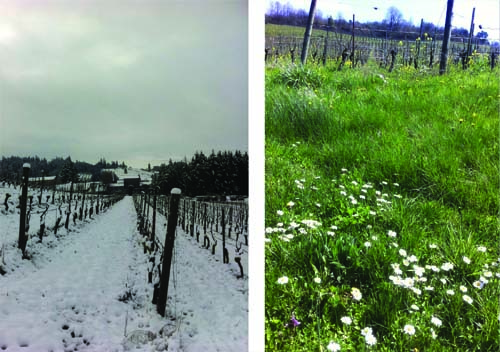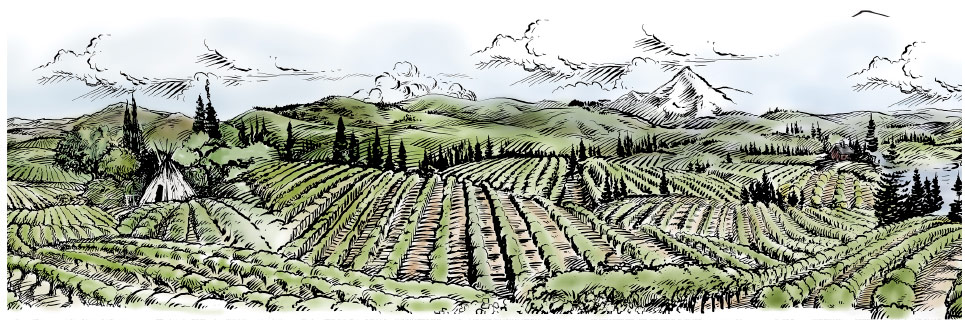Bee's Paradise
We celebrated Equinox in the vineyards 21 days ago and it is starting to look and feel like Spring. Equinox is the day when the hours of daylight equal the hours of darkness. Because the Earth tilts, the days grow longer after Winter Solstice but the quickening change and the longer days become undeniable and exciting after Equinox. The cherries have been blooming for a week now and the daffodils, too. The old-timers used to gauge the blossoming of the vines by the cherry blossom. We’ll see. Tulips are starting to show their vibrant colors and there is a buzz of activity when the sun comes out. Deciduous trees are starting to take the edge off of what has been a long grey winter with all their fresh green shoots.
Yesterday the sun came out and so I turned off my computer and went for a walk around our REX HILL vineyard. The vineyard was just radiating life and color. Not more than a week ago, the vineyard looked like the picture on the left. Today it looked like the picture on the right!

 It is a bee’s paradise in our Biodynamically farmed estate vineyard. Just in this photo there are five plant species flowering, all providing them with nectar and pollen. The white flowers are English daisies (Bellis perennis,) the purple flower in the left hand corner is Red Dead Nettle (Lamium purpureum)and just beyond the English daisies are Dandelions (Taraxacum officinale), Cat’s-ear (Hypochaeris radicata) and Field Mustard (Brassica campestris). When I walked up to the first stand of Field Mustard, I noticed there was a bumble bee, a honey bee and a mason bee all within a yard of each other. That’s cool!
It is a bee’s paradise in our Biodynamically farmed estate vineyard. Just in this photo there are five plant species flowering, all providing them with nectar and pollen. The white flowers are English daisies (Bellis perennis,) the purple flower in the left hand corner is Red Dead Nettle (Lamium purpureum)and just beyond the English daisies are Dandelions (Taraxacum officinale), Cat’s-ear (Hypochaeris radicata) and Field Mustard (Brassica campestris). When I walked up to the first stand of Field Mustard, I noticed there was a bumble bee, a honey bee and a mason bee all within a yard of each other. That’s cool!
All of these plant species I identified using the book Northwest Weeds: the Ugly and Beautiful Villains of Fields, Gardens and Roadsides by Ronald J. Taylor. It’s a nice simple book that catalogs most of the common weeds in the Pacific Northwest. These plants are found in a book about weeds but to me they aren’t weeds. To me, these plants play an important role in the farm’s ecosystem. They add biodiversity, provide habitat and a food source for a wide range of organisms. They also help reduce compaction from machinery, prevent erosion and help keep the soil healthy. In summary, it’s good to remember how important plants are to us and what they do for the environment. Next time you get out your hoe or your herbicide have another think about why you’re trying to kill that plant. It could be doing you a favor but you’ve just never realized it.

